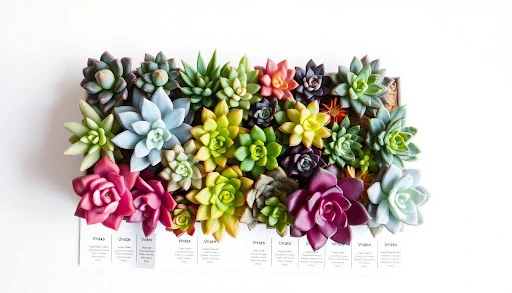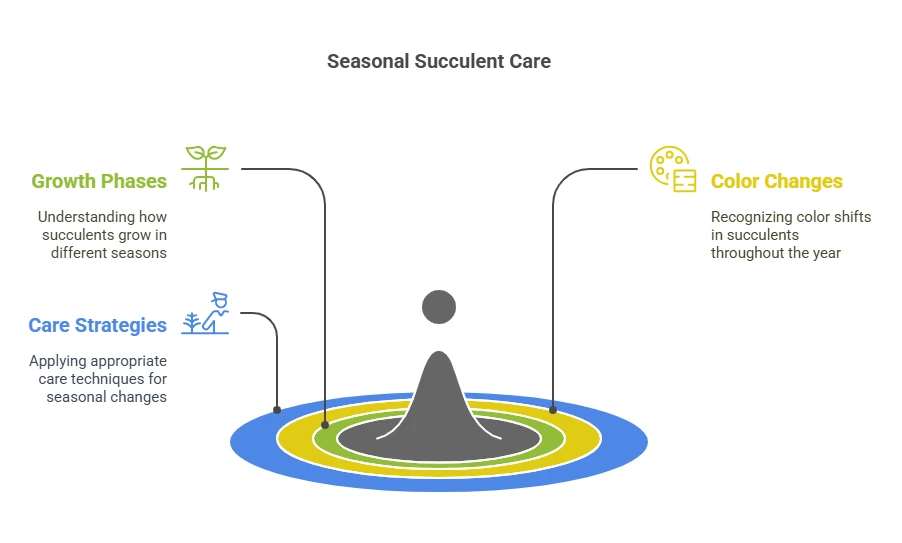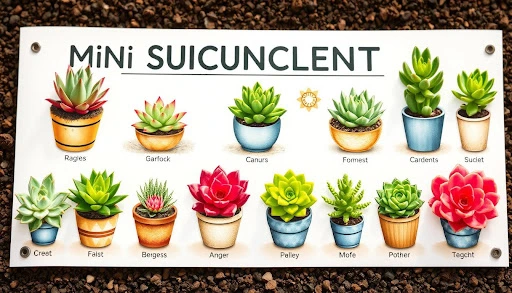I still remember wandering through my neighborhood nursery on a lazy Sunday afternoon, desperate to learn how to use a mini succulent identification chart.
That’s when this tiny, spiky succulent caught my eye.
Its deep emerald-green leaves were dotted with delicate white speckles like stars in a night sky.
I couldn’t resist – it came home with me that day.
The only problem? I had no idea what it was or how to keep it alive.
For weeks, I drove myself crazy trying to figure it out.
Was it an Aloe? A Haworthia? I scrolled through countless plant forums late into the night, comparing photos and descriptions, feeling more confused with each click.
When I was about to give up, a fellow plant lover introduced me to something that changed everything – a mini succulent identification chart.
With a glance, I could match leaf shapes, textures, and colors to find the perfect name—and the proper care routine.
If you have ever stood before your succulent collection, wondering if you are watering a Lithops or a Sedum, this guide is for you.
A mini succulent identification chart is not just a reference tool; it’s a game-changer for plant lovers.
Here’s how to use it effectively.
Key Takeaways
- A mini succulent identification chart provides a visual guide to identify different succulent species accurately.
- Understanding various succulent families’ key features and characteristics is essential for proper care and maintenance.
- A mini chart can help novice and experienced succulent enthusiasts enhance their plant identification skills.
- Seeking help from local nurseries and online communities can further aid in the identification process.
- Plant identification apps like Picture This can offer additional support in recognizing succulent types.
Using a mini succulent chart is a big step for succulent lovers.
It’s packed with pictures and info to help you learn about your plants.
Let’s explore how this tool can help you grow your succulent collection.
Understanding the Basics of Succulent Identification
Learning to identify succulents is a fun journey.
These plants come in many shapes, sizes, and colors.
They are great for both indoor and outdoor spaces.
Knowing the ordinary succulent families and their features is key to starting.
Common Succulent Families and Their Characteristics
Many succulent fans know families like Echeveria, Sedum, and Aeonium.
Echeveria plants grow in a rosette shape with thick, geometric leaves.
Sedum plants vary a lot, from vines to tall stems.
Aeonium plants stand out with their big, multi-headed rosettes and shiny leaves.
Key Physical Features to Observe
When you’re trying to identify succulents, look at their physical traits.
Important clues include leaf shape, color, texture, and how they grow.
Also, notice if they have ciliate hairs, epicuticular wax, and overall shape.
The Importance of Proper Identification
Knowing what succulent you have is more than just a hobby.
It’s essential to take care of them right. Each succulent needs different things, like light, water, and temperature.
By knowing what each needs, you can help them grow well, whether inside or outside.

“Proper succulent identification is the key to unlocking their full potential and ensuring their well-being.”
Getting Started with Your Mini Succulent Identification Chart
Starting your journey into the world of succulents can be exciting. A mini succulent identification chart is a great tool to have.
These charts help you sort succulents by their looks or family.
Look at your succulent’s shape, leaf type, and color. Then, match these with the pictures and details on the chart.
Notice what makes each succulent unique, like leaf edges, stem types, and how they grow.
Use the chart with online tools and apps for the best results.
With time, you’ll get better at spotting the unique traits of different succulents.
| Succulent Genus | Key Characteristics | Popular Varieties |
| Sedum | Over 470 species ranging from creeping herbs to shrubs | “String of Pearls” and “Burro or Donkey’s Tail” |
| Echeveria | One of the most popular genera with numerous similar-looking species | Echeveria ‘Lola’, Echeveria ‘Elegans’, and Perle Von Nunburg |
| Cotyledon | Includes species like Cotyledon tomentosa “Bear Paw” | Cotyledon tomentosa “Bear Paw” |
| Pachyphytum | Identified by thick, pillow-like leaves | Pachyphytum Oviferum “Moon Stones” |
A mini succulent identification chart is a great start, but don’t rely on it alone.
Add your research and observations for accurate identification. With practice, you’ll master the variety of succulents.

Essential Components of a Succulent Plant Structure
Understanding the structure of succulent plants is key to caring for them.
Each part, from leaves to roots, helps them survive in dry places, and knowing these parts is vital for their health.
Leaf Shapes and Patterns
Succulent leaves vary greatly in shape and pattern. Some, like Echeveria, have a rosette shape.
Others, like Sedum, have stacked stems. These shapes help identify and grow succulents.
Stem Characteristics
Succulent stems can be thick or thin. They support the plant and store water. Knowing the stem types helps in growing different succulents right.
Root System Types
Succulents have shallow roots that absorb water well, helping them survive with little water.
Knowing the root type is important for caring for them.
Learning about succulent structure helps in caring for many plants. It’s useful for both beginners and experts.
It ensures the health of plants like Aloe vera and String of Pearls.
Distinguishing Between Similar-Looking Succulents
Exploring the world of succulents is exciting but can be tricky.
Many succulents, like Echeveria and Sempervivum, look very similar.
It makes it hard to tell them apart. But, with careful observation and the right tools, you can spot the differences.
Echeveria and Sempervivum have distinct features. Echeveria has smooth, soft leaves.
Sempervivum, or hens and chicks, have hairy leaves.
Also, Sempervivum can handle colder weather better, making them great for outdoor gardens in cooler areas.
Aeonium and Echeveria might look alike at first glance. But their stems are different.
Aeoniums have long, thin stems. Echeveria have more compact, rosette-like shapes.
- Leaf thickness, hair presence, and growth patterns help tell similar succulent types apart.
- Noticing these tiny details is key to correctly identifying your indoor succulents and using your mini succulent identification chart well.

“The devil is in the details when it comes to succulent identification.
Mastering the art of observation is the first step to becoming a true succulent connoisseur.”
Learning to tell similar succulents apart can broaden your knowledge and appreciation for succulents.
So, sharpen your senses and start your succulent identification journey!
Using Visual Markers for Quick Identification
Visual markers are key for identifying succulents.
You can tell them apart by looking at their colors, growth, and textures.
This guide helps you spot these differences, making you a pro at identifying succulents.
Color Variations and Patterns
Succulents come in many colors, like greens, blues, reds, and purples.
Some have patterns on their leaves or stems. Knowing these colors and patterns helps you identify succulents.
Growth Habits and Forms
Succulents grow in different ways, like rosettes or vines.
Their shape and structure give clues about what they are.
These signs make identification easy, whether it’s a tall cactus or a low-growing sedum.
Texture and Surface Features
Succulents have unique textures, from smooth to fuzzy.
Features like hairs or spines can tell you a lot about a succulent.
Looking closely at these details helps you tell similar plants apart.
Learning to notice these visual markers improves your ability to identify succulents.
With time and practice, you’ll become proficient.
Then, you’ll be able to explore the world of succulents with confidence, discovering their beauty and diversity.
Common Succulent Families and Their Unique Identifiers
Exploring the world of succulents is exciting, but knowing how to identify them is essential.
Each succulent family has unique traits that help you recognize and care for them.
Let’s look at some ordinary succulent families and their distinctive features.
The Echeveria family is known for its thick, fleshy leaves that form stunning rosettes.
These plants come in many colors, from bright greens to soft pinks and purples.
Sedum has smaller, clustered leaves that can grow in a cascading way. Euphorbia stands out with its unique stem structures and toxic sap.
Crassula, home to the beloved jade plant, has over 200 varieties, each with its own charm.
Sedum succulents come in different types, like creeping, tall, and trailing.
Senecio species include trailing and upright plants, like the popular String of Pearls.
- Pachyphytum succulents have chubby, elongated leaves and striking flower spikes.
- Kalanchoe includes fuzzy varieties known as Panda Plants, with a velvety coating that adds a delightful textural element.
- Cacti, the most recognizable spiky succulents, are known for their iconic appearance and resilience.
- Euphorbia species have spines mainly along raised ridges, not covering the entire plant.
- Stapelia, resembling cacti, lacks leaves and features unique starfish-like flowers with an enticing scent to attract pollinators.
- Agave, a large succulent, is renowned for its spiny leaf margins, resilience, and popularity in desert gardens.
By learning these unique identifiers, you’ll better identify and care for your succulents.
With practice and observation, you’ll soon be a pro at identifying succulents!
Seasonal Changes and How They Affect Identification
Caring for outdoor succulents means knowing how they handle seasonal changes.
These plants change a lot throughout the year, so it’s key to understand how to care for them to keep them healthy.
Growth Phases
Succulents go through different growth phases. Some slow down in cold weather, while others grow fast in warmer months. Knowing these patterns helps in caring for and identifying them.
Color Changes Throughout the Year
Succulents’ colors can change with the seasons.
Some get brighter in sunlight or cooler weather, while others may lose their color in hot or dark times.
Knowing this helps in giving the right care.
Learning about succulent changes makes you better at caring for them. It lets you enjoy their beauty all year.
This way, your succulents stay healthy and colorful.

Advanced Tips for Using a Mini Succulent Identification Chart
As a succulent lover, I’ve found that identifying these plants requires more than just the basics.
To get good at it, we must learn advanced techniques to help us understand and enjoy these plants even more.
One key tip is to look at more than one thing when identifying a succulent.
The mini chart is a good start, but looking at where it grows, how fast it grows, and when it blooms can help a lot.
These details can help us figure out what kind of succulent it is and tell it apart from others that look similar.
Another essential technique is using a magnifying glass.
Looking closely at a succulent’s leaves and stems can reveal a lot.
This is beneficial when we’re trying to tell apart plants that look alike or see different versions of the same succulent.
- Cross-reference multiple characteristics like native habitat, growth rate, and flowering patterns
- Use magnification to observe fine details like leaf serrations and stem textures
- Compare numerous specimens of the same species to understand variations within a type
The mini succulent chart is a great tool, but using it with these advanced techniques is even better.
We can learn about succulents by getting good at looking at different things, using a magnifying glass, and comparing plants.
It makes us true experts in the world of succulents.
| Succulent Characteristic | Advanced Identification Technique |
| Native Habitat | Cross-reference with growing conditions and adaptations |
| Growth Rate | Observe changes over time to distinguish species |
| Flowering Patterns | Identify unique bloom characteristics and timing |
| Leaf and Stem Details | Use magnification to observe fine textures and structures |
| Specimen Variations | Compare multiple plants of the same species |
You’ll gain a deeper understanding and appreciation for succulents by learning these advanced techniques.
Explore the fascinating details of these plants, and let your mini chart guide you on this exciting journey of discovery.
“Unlocking the secrets of succulents requires a keen eye and a deep dive into their intricacies. With the right tools and techniques, the possibilities for discovery are endless.”
Troubleshooting Identification Challenges
As a beginner’s guide to succulents, we face common identification challenges.
It’s hard to tell look-alike succulents apart and identify hybrids.
But, with the right tools and knowledge, you can learn to identify succulents well.
Look-alike Species
Some succulent species look very similar.
For example, Echeveria and Graptoveria hybrids can be complex and difficult to distinguish.
To solve this, look closely at leaf shape, color, and growth patterns. A detailed succulent identification chart can help you tell these look-alikes apart.
Hybrid Varieties
Hybrid succulents, made by crossing two species, are tricky to identify.
They often show traits from both parents.
When unsure about a hybrid, study its growth habits, leaf structure, and unique features.
Expert help or using plant identification apps can be very helpful.
Learning about common look-alikes and hybrid succulents will help you get better at identifying them.
With practice and attention to detail, you’ll become great at recognizing the many succulent types in your collection.
Conclusion
The mini succulent identification chart is a must-have for anyone who loves succulents. It helps you take better care of your plants and keeps you safe from toxic ones.
Using it regularly will help you better identify succulents as you gain experience.
Identifying plants is a journey, and even experts face challenges.
Keep using your chart and pay attention to your plants’ unique features.
This way, you’ll enjoy learning more about succulents.
This chart is an excellent tool for both new and experienced succulent growers.
It helps you understand your plants better, ensuring they grow well. With this chart, you’ll have a fulfilling experience with these remarkable plants.
FAQ
What is a mini succulent identification chart?
A mini succulent identification chart is a handy tool for succulent lovers. It helps you identify different succulent species. This is key for their care and upkeep.
How can a mini succulent identification chart help me?
The chart shows pictures of succulent families and their features. Learning to use it well can improve your care for your plants.
What are some common succulent families I should know about?
You should know about Echeveria, Sedum, and Aeonium. Look at leaf shape, color, texture, and growth to tell them apart.
How do I start using a mini succulent identification chart?
First, familiarize yourself with the chart’s layout. Then, look at your plant’s shape, leaf structure, and color and compare these to the chart’s images and descriptions.
What are some key physical features I should look for when identifying succulents?
Notice leaf thickness, hairs, stem types, and growth habits. These details help you better use the chart and care for your succulents.
How can I distinguish between similar-looking succulents?
Look for differences in leaf texture, hairs, and growth patterns. The chart will give you details about similar species.
How can visual markers help with quick succulent identification?
Visual markers like color, growth habits, and surface features are key. The chart should highlight these for fast identification.
What are some unique identifiers for common succulent families?
For example, Echeveria have thick rosette leaves. Sedum have smaller, clustered leaves. Euphorbia are known for their unique stems and toxic sap.
How can seasonal changes affect succulent identification?
Succulents can look different with the seasons. They may grow more or change color with temperature and light. The chart should note these changes to avoid mistakes.
What are some advanced techniques for using a mini succulent identification chart?
Advanced use involves looking at multiple traits, such as habitat and growth rate. Using a magnifier can also help see small details and compare plants.
How can I troubleshoot identification challenges?
Look-alike species and hybrids often present challenges. The chart should help with common confusion and give tips for telling species apart and spotting hybrids.








